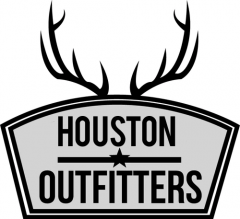Why Go Texas Hog Hunting?
Texas Parks & Wildlife biologists estimate hog population in Texas now nearly two million! Known as Russian Boar, Feral Hog or just plain Pigs, the wild swine in Texas is rapidly gaining popularity as a hunting target. The reasons are numerous.
- they’re smart, so the hunting can be challenging!
One scientific study says that pigs are the second smartest animal behind only chimpanzees. - you may take hog by any method, year-round in Texas.
That means; no need to wait for deer season to warm up the gun barrel. - wild pork is excellent meat; lean, and flavorful!
- chances of success are great. Texas Parks and Wildlife now estimate the pig population in Texas may exceed two million, and, we hunt right in the densest hog population areas in the state.
- And finally, number five reason; boar hunting is A LOT OF FUN! Oink! Oink!
Texas Parks & Wildlife biologists estimate pig population in Texas now over two million!
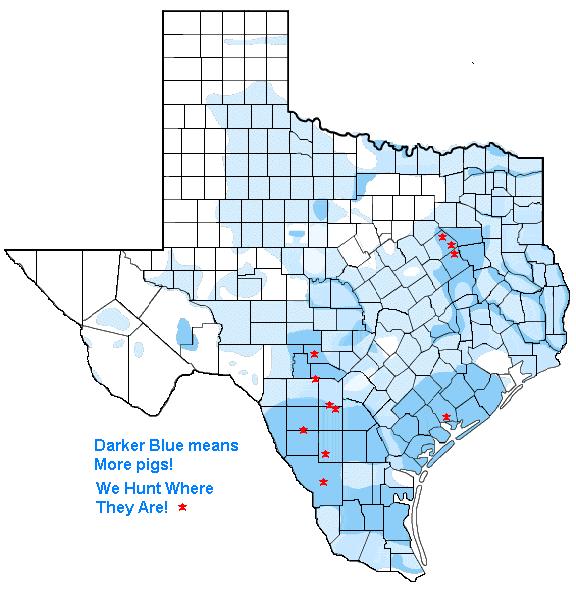
We would like to invite you to come hunting with us here at hunting-in-texas.com We can offer you many different packages; camping, rustic, moderate or full-service luxury. Some of our swine are nearly pure Russian Boar, some pure Feral Hogs, and there are lots and lots of crossed pigs!
Anatomy of Hogs – Shot Placement!
In the distance, I hear a rifle report and wonder if I’ll have an animal to haul back to camp, or if I’m going to hear the same old story; “He should be close! I shot him right behind the shoulder.” All too often, it’s hours later, and we are still looking for that animal. It seems that no matter how much info there is out there for the hunter to read BEFORE they go hunting, and no matter how many times I tell my hunters otherwise in orientation, people still have the idea that they should shoot an animal “behind the shoulder”. Even on an animal with rather large lungs, like a whitetail or pronghorn, the lungs stop very shortly behind that shoulder; too shortly in my opinion. All body shots should be THROUGH the shoulder, NOT BEHIND THEM. Looking closely at the overall kill zone of these animals will quickly reveal that through the shoulder, NOT behind it, puts the bullet in the center of the kill zone. That allows the most leeway for error. As a bonus, if you bust down the shoulders, the animal can’t run at all.
.
The situation is particularly pronounced in the case of feral hogs. Their lungs are smaller than other big game and tucked tightly up BETWEEN the shoulders. If you must body shoot a hog, please make it squarely through the shoulders. If you get behind the shoulder AT ALL, all you are going to hit is the stomach. That is a deadly shot, but finding your animal may be quite difficult, and death may come slowly and painfully. Losing animals, or failing to dispatch them quickly, is not very sportsmanlike. Besides, cleaning a gutshot animal is no pleasure.
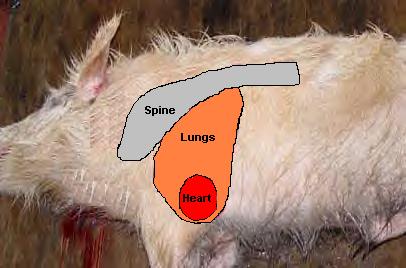
THERE IS AN EXCEPTION to shooting through the shoulders! If you are shooting at a trophy boar, you must deal with “the shield”. Over the entire chest cavity, boars develop a shield of cartilage-like material. It is intended to protect them from the tusks of other boars in fighting over females and territory. This shield maybe three inches through, or even thicker on a very large, old boar. It will stop arrows, shotgun slugs, black powder balls, even many modern cartridges. Only a deep penetrating type bullet will get through it to the vitals, but even that won’t guarantee a recovered animal. Because of the way the shield is made, and the way deep penetrating bullets stay together, there is seldom ever a good blood trail. The hole just isn’t big enough, and the body tissues plug it up. Virtually everybody shot big boar we’ve ever recovered, has been done so by simply looking around until we stumbled upon it. There is a trackable blood trail on maybe one out of 50 shoulder hits on large boars.
SO WHAT SHOULD YOU DO? Well, a real sportsman will know his limitations and that of their weapon and stay within those limits. That might mean passing up the shot, but few have that kind of willpower. If you are not close enough and good enough to put a shot in his ear canal, straight to the brain, then here is the best second option. Wait until you can get the boar in a quartered away body position. NOT BUTTOCKS STRAIGHT TO YOU, just quartered away 30 to 45 degrees. Aim LOW at the FRONT of the shoulder ON THE OPPOSITE SIDE of the boar and let fly. This should make the bullet or broadhead enter behind the shield on the close side of the animal (or at least where the shield is a lot thinner), and then pass through part of the stomach, the liver, and at least one lung, hopefully both lungs, and maybe catch the aorta, too. The bullet or point will stick in the base of the neck or opposite shoulder. A pass-through is nearly impossible. Done properly, the animal will not go far or last long. You should get some sort of blood trail if you kept the hit low, and/or a smelly old guacamole trail if you opened the stomach up enough.
www.texasboars.com has done an excellent job of showing this different anatomy of a hog. They do it in a series of photos, depicting a real hog stripped of its skin, then shield, then muscles, then rib cage and shoulder bone, to reveal those small lungs and small heart, hidden well forward in the chest cavity. The hog shown is a young boar of maybe 70#, and even he has a half-inch thick shield, plus two inches of skin, muscle, and bone covering his vitals.
Personally, I shoot hogs almost strictly in the head/neck, either right behind the ear, where the head and neck come together, or where the neck and shoulder joint. It just depends on the distance of the shot, and the angle of the animal’s body to me. I do this because it puts the animal down on the spot, and they are usually dead before they hit the ground. This is important, because everything that grows in my part of Texas will either poke you, prick you, stick you, bite you or sting you, so I don’t want to have to trail a shot animal off through the bushes. It also makes for better eating, because an animal that is dispatched instantly never has the chance to pump itself full of adrenaline and lactic acid, both of which toughen the meat and impart a poor flavor.
.
Using the behind the earshot placement, I have dropped 175-pound boar with a .22 rimfire, and up to 375-pound boar with my .243. BUT, I get to practice this stuff A LOT, so I shoot especially well. Not everyone can. Know your limitations, and those of your weapon of choice, and stay within those limitations.
How Old is That Pig?
Nearly every time one of my hunters shoots a hog, I hear that question; how old do you think that pig is? Well, until they are five (the pig, not the hunter), that’s a relatively easy question to answer with a set of jaw spreaders and a flashlight. All you have to do is examine their teeth.
The exact things to look for are all to be found on the rearmost jaw teeth. You can ignore the front teeth, the tusks, and the Euro teeth, if present. The Euro tooth is a very small tooth, a short distance rearward of the tusk on each jaw. Only European Boar and hybrids of domestic pigs and Boar will have these teeth.
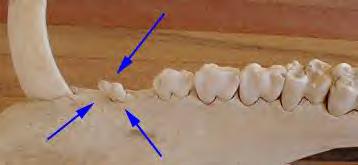
On sows and boar less than 18 months old, there will normally be three adjoining teeth in this rear most position. The first two are thin, looking much like a human-canine tooth in shape. The third will be a tricuspid molar. Tricuspid means it will appear to have three parts or columns joined together to form the one tooth.
By the time the hog hits it’s second birthday, a fourth tooth, a bicuspid molar (two parts or columns), will have also fully erupted through the gum line.
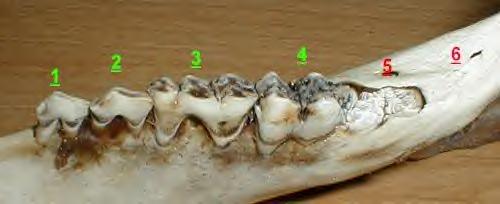
On the photo, #3 is tricuspid – #4 is bicuspid.
From nearly two years old, until about 2 and a half years, the pig will lose the first three teeth, one at a time, and replace them. The two thin tooth replacements will look the same (except newer). The tricuspid molar becomes a large, bicuspid molar.
By the hog’s third birthday, a fifth tooth, another bicuspid molar, will have erupted through the gum line.
By the hog’s fourth birthday, a sixth tooth, a tricuspid molar, will have partially erupted through the gum line, showing two of the three cusps.
By the fifth year, that sixth tooth will fully erupt. From now on, the only way to know how old the hog is is by the amount of wear shown on the teeth. No more teeth will show up. When all these molars are all worn out, at about age eight, the hog can no longer get the nutrition they need from what they eat and they rapidly begin to decline in health. It is rare for a wild hog to live past eight years old.

To oversimplify this whole process, you can generally just count the rear jaw teeth on one jaw, and subtract two to get the age of your hog. That is, as long as they are less than four years old. If that sixth tooth is fully exposed (all three cusps), the pig is at least five.
Recipes
Wild Pork Roast
Serves 8 to 10 real hungry fellars.
Start with the ham of an 80 -90-pound hog, or two smaller shoulders.
This should be about 7 – 8 pounds of bone-in meat.
Place meat on a rack in a large roaster pan.
Sprinkle meat with a little black pepper and Season-It-All.
Cut up potatoes, sweet onions, carrots, and celery and place ON TOP of meat.
Pour 8 – 10 ounces of zesty Italian dressing over the top of this.
Season lightly again with black pepper and Season-It-All.
Seal the pan TIGHTLY with aluminum foil.
Bake at 325 degrees for 2 hours 30 minutes.
Remove aluminum foil and turn oven to 400 degrees.
Baste with drippings and cook until nicely browned (about 10-15 minutes).
This is one of the meals regularly served in our Texas hog hunting camps. If you come to hunt with us, you will probably get to try this dish. We normally start with a nice salad and serve dinner rolls along with the main course. Peach cobbler makes a great dessert. If drinking wine with this meal, I prefer a Rose or Blush (pork is the other white meat, you know?).
Three Little Pigs
Serves 7 or 8 full-grown men at camp.
Pull both back straps (boneless) from a larger hog (150 – 200#).
This should be about 6 – 7 pounds of meat.
Cut these into about foot-long chunks.
With a long, thin knife (a fillet knife works great), cut a hole LENGTHWISE into the meat. Do this by inserting the knife all the way into the center of the end of the meat piece, then cutting toward the outside edge. DO NOT cut all the way out. You want it to be like a tube.
Insert a LONG piece of your favorite link sausage into this tube.
Keep inserting until the entire tube is filled.
Repeat for all pieces (usually 4).
Season this meat assembly to taste with, pepper, garlic powder, and onion powder.
Cover each tube completely with bacon.
Place in a baking dish with a can of beef broth or 2 cups bouillon.
Bake TIGHTLY COVERED at 325 degrees for 2 hours 15 minutes.
Remove cover and turn oven up to 400 degrees.
Baste well with drippings and cook until bacon is crisp (about 10-15 minutes).
We sometimes serve this meal at our hunting camps, but that backstrap is almost too good for us to share. If you come to hunt with us on a package with an “upgraded menu”, you will probably get to try this dish. We normally start with a young spinach leaf salad and serve homemade bread loaves along with the main course. Apple pie ala mode makes a great dessert. If drinking wine with this meal, I prefer a darker Blush or Merlot. With the bacon and sausage, you’ll want a wine with more body than a Rose or lighter Blush.
Pit Style Pig Ribs
Serves 6 – 8 hungry hunters.
Use a full rack of ribs from a larger hog (150 – 200#) or both from a smaller hog.
Use only the ribs from a hog in good body condition. If the ribs look poor to start, they will probably finish poorly, too.
Pull as much connective tissue off the rib cage as possible.
Put shallow slits through the connective tissues on the inside of the slab, between each rib, and deep slits across the ribs on the meat side of the slab.
Brush on plenty of PICKLE JUICE. Yep, you read that right!
The only extra seasoning needed is some black pepper.
Cook directly over a medium-low, mesquite wood fire until getting just a little bit of blackness around the edges of the slab (usually about 30 – 40 minutes). Be sure to baste well with pickle juice every ten minutes.
Lightly brush with your favorite bar-b-q sauce and wrap well in aluminum foil.
Move to the side of the fire, where you can hold your hand for 15 – 20 seconds before getting too hot.
Cook on this low heat for 1 hour, turning and spinning the meat around regularly so as to cook evenly.
Remove the aluminum foil and test for doneness.
Finish directly over what flame remains, if needed.
Potato salad, coleslaw, carrot salad and/or macaroni salad are all great side dishes for this meal. Texas toast from the grill, or tortillas, are the usual bread side, and pecan or sweet potato pie are perfect desserts. No wine with this Texas traditional dish. It’s beer or tequila only if drinking alcohol! Sweet tea, if not!
